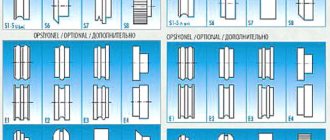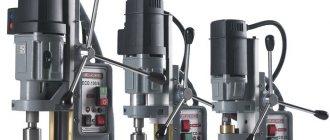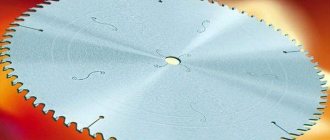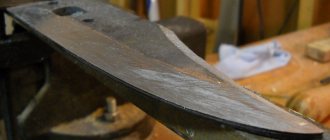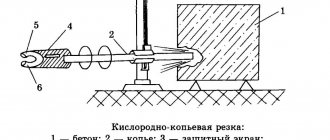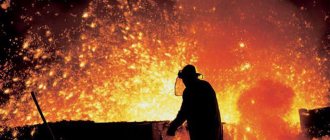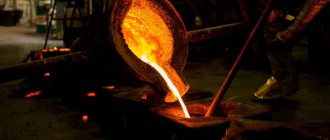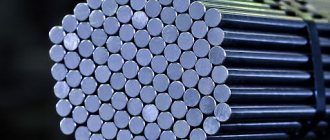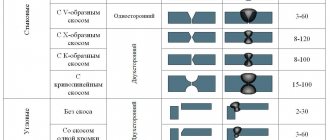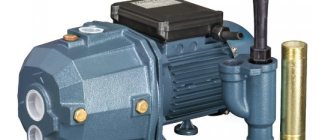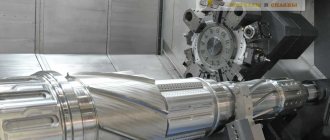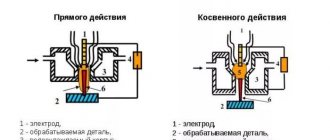A cutting wheel is a type of consumable tool. It is designed for cutting a wide variety of materials. In terms of design, it looks like a disk with a surface on which a layer of abrasive mixture is applied. Rigidity is ensured by fiberglass mesh reinforcement. This technological solution prevents large fragments from breaking off. The destruction of the disk is caused solely by the incorrect choice of cutting mode or failure to comply with the requirements for correct operation.
Types of cutting wheels
The main criterion used to categorize cutting discs is the type of material they work most effectively with. In accordance with this feature, circles are:
- on metal. Area of use: cutting sheet metal, U-shaped profiles - channels, L-shaped beams - angles, pipes, including profiles, and fittings;
- on wood. Along the perimeter of the outer edge of the circle there are sharp straight, beveled, trapezoidal and other shaped teeth. Discs of this type are also used for cutting MDF panels, plasterboard sheets, double-glazed window elements and pipes made of plastic;
- on stone. They are used for cutting flat and corrugated asbestos-cement sheets, paving stones, stone structures that can withstand heavy loads of paving slabs, as well as objects made of concrete and sand-lime brick (see figure).
Another criterion used to classify cutting discs for angle grinders is their production technology.
Abrasive discs. The structural basis of such a circle is made up of at least 2 layers of the so-called. fiberglass mesh, and a mass including abrasive materials is applied on top of it. These could be:
- electrocorundum This is a super-hard, resistant to chemically aggressive environments and fire-resistant material, which is based on aluminum oxide A2O3;
- silicon carbide. Chemical inorganic binary compound of the elements carbon (C) and silicon (Si);
- corundum. The most common is zirconium corundum (ZrO2+A2O3 alloy). It is characterized by hardness, density and, at the same time, significant viscosity.
The technology for manufacturing discs intended for cutting metal objects involves heat treatment. After passing this stage, the product acquires increased resistance to destructive loads. There are two types of abrasive consumables/materials based on configuration. These are the disks:
- concave (more precisely, their seat sleeve is concave);
- flat.
Diamond discs. Used for cutting objects made from materials characterized by increased strength:
- natural/natural stone;
- asphalt pavement;
- non-slit red brick of grades M300, M250 and M200;
- marble, including artificial;
- fine-grained granite - the most durable of all types of this rock;
- concrete of all common grades - B40, B30, B25, B20, B15, etc.
Made from steel. The end surface of the disk is covered with particles of abrasive mass. They represent diamond chips. The range of variation of the width (S) of the diamond-containing layer is as follows: 1.50 mm ≤S≤ 3.0 mm.
Three types of diamond-containing cutting wheels are supplied to the market:
- segmented. The cutting edge with an abrasive mass applied to it is a collection of individual segments. Using a consumable tool of this type, dry cutting is carried out;
- solid. Structurally, it is made in the form of a monolithic disk with a continuous diamond abrasive edge. Designed for dry cutting;
- Turbo disc. The configuration of its diamond-containing edge resembles a wave with inclined grooves. Their presence reduces the area of contact with the processed material. This design solution ensures that the cooling process occurs naturally. The disk is essentially universal. Used for both types of cutting: dry and with coolant.
Grinding and polishing discs
Depending on the type of material being processed and the required quality of its grinding or polishing, discs with different working surfaces are used:
- sponge or fabric - used, as a rule, in combination with special paste or liquid products;
- felt, solid or made on a plastic base with many transverse, densely planted felt petals, also used with polishing pastes;
- discs with replaceable sandpaper of different thicknesses and fine abrasive ones for cleaning and grinding.
For convenient and high-quality processing of large surfaces, rough grinding of logs and rounding of the edges of various products, grinding discs of a special conical shape are used.
Grinding and polishing discs are suitable for cleaning and polishing various types of surfaces to an ideal state: from steel to metal alloys; they are actively used in car services when processing body coatings.
Bundle type
The type of bond has a direct impact on the quality of the saw, the level of work productivity, as well as the strength of the product. The production of cutting discs is based on the use of two types of bond.
Organic. A ligament of this type is in turn divided into:
- bakelite. To create its base, formaldehyde resins are used - liquid and/or crushed to a powdery consistency - together with fillers: pyrite (this mineral contains iron disulfide (FeS2)), alabaster (calcium diacquasulfate), cryolite (a mineral belonging to the class of natural fluorides ). Cutting wheels created on the basis of a bakelite bond are characterized by increased resistance to external influences working on compression/bending. However, they do not tolerate contact with alkaline coolant very well. The permissible content of such a water-soluble chemically strong base is no more than 1.5%. As for the rotation speed, its value can exceed 80 m/sec. The main disadvantage of the bakelite binder is its low heat resistance. It will become fragile if it heats up to 200°C during operation, and will begin to burn out at 250°C -300°C;
- vulcanite. It is a mass that includes 2 components – sulfur and rubber. Subjected to a heat treatment procedure. The consumable instruments in question made on its basis are characterized by a dense structure without sacrificing elasticity. The strength of the vulcanite bonded blade ensures a cutting speed of up to 80 m/sec.
Inorganic. This bond is ceramic. It consists of the following components:
- feldspar is a mineral belonging to the class of silicates;
- quartz - the main mineral from the group of silicas;
- chalk – a type of limestone (CaCO3);
- liquid glass - an alkaline aqueous solution of potassium silicates K2O(SiO2)n and/or sodium silicates Na2O(SiO2)n. Another common name for this substance is silicate glue;
- talc is a mineral belonging to the class of silicates (Mg3Si4O10(OH)2);
- refractory clay - kaolin, fireclay, annealed until it loses its plasticity properties.
The ceramic bond increases the water resistance of the cutting wheel. And it itself has the following qualities: resistance to contact with chemically aggressive substances and a high level of fire resistance. The disadvantages include: it does not tolerate bending loads well and is sensitive to impulse (impact) impacts.
Coupling is performed in one of several ways:
- silver soldering circle;
- sintering;
- laser welding;
- galvanic method.
Silver solder
Used for large diameter diamond blades intended for wet cutting on stationary machines - the segment without constant cooling quickly disappears. The solder connection is not heat-resistant, but the cutting part damaged in individual segments can be restored.
Sintering
Pressed polymetallic powder containing diamonds is sintered under pressure with the disk blade at a temperature of 700-1000°C. This is how complex disk segments of medium and small diameters are manufactured. The method increases the service life, but increases the price of the product.
Laser welding
The most durable mounting method. These discs are used for both dry and wet cutting. When dry cutting, the disc is not damaged and retains its shape.
Galvanic method
With this method of fastening diamonds, only one layer can be applied, which prevents the disc from self-sharpening. But the number of cutting elements can be large, and this allows for extremely precise and clean cuts. The technology is used in the production of diamond cutting discs used when working with materials of low hardness.
The size, quantity, quality and method of arrangement of diamonds, the specific composition of the binder - all this determines the combination intended for processing a particular material.
The work of a diamond cutting disc is not cutting, but grinding and crumbling the material being processed. Diamond crystals are held in place by a metal lattice and a binder. When they are ground down, the stones crack and fall out. There is a direct relationship between the hardness of the material and the service life of the disc. With optimal selection of segment and material, a balance between resistance and cutting properties is maintained. As a result, the crystal is used until it is completely destroyed, and then a new, exposed diamond comes into play.
Discs for cutting dense materials must have a soft, quickly crumbling grid. At the same time, the diamonds will just as quickly replace each other, and the segment remains operational as it is ground down. In blades used for cutting soft materials, the grid is resistant to abrasion and the diamonds last longer.
The same factor ensures the correct selection of the bond between which the diamonds are distributed. The bond can be hard (steel and cobalt fills the gaps), soft (including bronze) and medium (tungsten carbide).
A soft binder is used in discs processing hard surfaces - its use when working with soft material leads to accelerated consumption of the segment. Used when cutting granite, reinforced concrete, hard metals.
A solid binder, on the contrary, is intended for processing soft materials: clothes, silicate, asphalt, etc.
For each disk there is a specific marking that describes its characteristics. Some manufacturers indicate in the labeling the type of material for which it is intended for processing:
- B – concrete cutting;
- U – universal diamond discs;
- M – discs for cutting hard materials and marble;
- F – processing of ceramic tiles;
- A – cutting asphalt;
- P – professional diamond discs;
- PP – circles of the highest class;
- PE – inexpensive professional discs.
Diameters of cutting discs
On the shelves of building materials stores there are cutting wheels with different external diameters. For household work, consumables/tools with the following values of this parameter are most in demand:
- 115.0 mm. Used to work with small angle grinders;
- 150.0 mm;125.0 mm. The area of destination is “grinders”, characterized by medium dimensions and not the highest power;
- 180.0 mm; 230 mm. They are used mainly in conjunction with professional electric drive devices.
A standard cutting wheel has an internal diameter of 22.3 mm. But there are products on the market with other values of this indicator, for example, 32.0 mm.
How to calculate consumables
There are no documents regulating the consumption of an abrasive disc on metal. Two main methods can be used to determine these parameters:
- Developments of the Soviet period . Documentation from the Ministry of Montazhspetsstroy from the times of the USSR is suitable for this. But these data do not contain circles with parameters that are produced by modern manufacturers.
- Calculate your own standards . This method is suitable when performing identical work frequently. Each manufacturer has its own standard and after some time you can accumulate a decent database.
Abrasive substance
The quality of the result of the work of wheels intended for cutting, in addition to the grain size, is determined by the configuration, as well as the characteristics of the abrasive substance. Solid silicon carbide particles are more suitable for machining non-ferrous soft alloys and, in general, non-metallic materials. The shape of electrocorundum grains is optimal for cutting carbon steel objects.
One of the important properties of an abrasive is its degree of tolerance to high temperatures. The best heat resistance indicators are inherent in corundum abrasives. The maximum value of their operating temperatures (T) reaches 1900°C. Carbides of the element boron (B) and diamond-containing abrasives are characterized by heat resistance of 700°С ≤Т≤ 800°С. This figure is the lowest among similar substances.
Thickness of cutting discs
It must be said right away that the thickness of cutting wheels is not standardized. The value of this parameter depends on their outer diameter. Below are the most commonly found numbers on the market that display the thickness of the discs (S) with outer diameters:
- 230.0 mm. 1.60 ≤S ≤ 4.0 mm;
- 180.0 mm. 1.0 ≤S ≤ 4.0 mm;
- 150.0 mm. 0.8 ≤S ≤ 3.20 mm;
- 125.0 mm. 0.8 ≤S ≤ 3.20 mm;
- 115.0 mm. 1.0 ≤S≤ 3.20 mm.
It is rational to use discs with a small thickness in conjunction with low-power angle grinders. The lower the value of parameter S, the faster and easier the cutting occurs. The reason for this phenomenon is obvious: the level of resistance of materials is lower. Working with a thick disk will require great physical effort from the performer. The figure shows the layer-by-layer structure of a conventional cutting wheel. Studying it will help you find out which elements combine to ultimately form the thickness of such a product.
Discs for working with aluminum
Non-ferrous metals have increased viscosity, which is why when cutting them with discs for steel and cast iron, various difficulties may arise due to the fact that chips are not removed from the cutting zone. It contributes to the clogging of the abrasive and impairs its cutting ability. Therefore, when cutting products made of aluminum or alloys based on it, special discs with a softer knitting are used. This promotes self-sharpening of the discs, but contributes to more accelerated wear.
Abrasives for cutting aluminum are produced by a limited number of manufacturers. Most manufacturers use a wider range of applications in the designation - for working with non-ferrous metals.
Advantages and disadvantages
Like any product produced by modern industry, cutting wheels have their own pros and cons. Let's consider only the main ones.
Abrasive consumables
Among the advantages of disks of this type it is worth highlighting:
- during active use the wheel does not become dull;
- cooling occurs naturally due to the porous structure;
- there is a wide range of product items on the market;
- acceptable price;
The disadvantages of abrasive consumables/tools include:
- wear out quickly;
- cutting is accompanied by the appearance of a characteristic, rather strong odor in the surrounding area;
- During the work, sheaves of bright sparks are formed.
Diamond cutting wheels
Such products have the following advantages:
- minimal formation of sparks during the cutting procedure;
- absence of a strong unpleasant burning smell;
- high wear resistance;
- increased cutting accuracy.
Among the disadvantages of diamond-containing cutting wheels, home craftsmen with extensive experience highlight:
- low level of thermal resistance;
- considerable price.
Classification of discs for grinders
Grinder circles can be divided into several types:
- cutting;
- polishing and grinding;
- sharpening;
- peeling.
What materials are used for processing:
metal;- wooden;
- concrete;
- glass.
Grinder wheels differ in shape, thickness, diameter and material of manufacture. For simple operations, conventional flat abrasive discs are used. When cutting or grinding in hard-to-reach places, use plate-shaped wheels with recessed fasteners.
Selection rules
The choice of consumables/tools should be approached with full responsibility. Otherwise, additional unnecessary costs of time and money may appear. In this regard, it is worth listening to the opinion of professional builders.
Cutting wheel
An ideal blade designed for cutting various objects has the following characteristics:
- made with a reinforcing component based on bakelite binder;
- abrasive substance: for stainless steel structures – white electrocorundum; for objects made of iron or its alloys (these are so-called ferrous metals) - simple electrocorundum;
- cross-sectional size of a circle for cutting metal products in everyday conditions – from 1.60 to 2.0 mm;
- the outer diameter of the disk for cutting metal objects for domestic purposes is 125.0 mm;
- When cutting objects made of steel is intended, the abrasive must be formed from fine particles.
Diamond wheel
Selecting a wheel for diamond cutting should take into account the following expert recommendations:
- for working with structural elements made of non-cellular concrete, brick and granite objects, the most suitable consumable material/tool is a segmented disk, the width of the diamond-containing layer (S) lies within 2.50 ≤ S ≤ 3.0 mm, and the outer diameter of this product – 230 mm;
- if it is necessary to create grooves along which engineering and technical communications will be laid, preference should be given to a segmented circle with dimensions of an outer diameter of 350.0 mm and a diamond-containing layer of 3.50 mm;
- It is recommended to process marble and ceramic tiles using a solid diamond-coated cutting tool. Cutting of these materials must be done with water cooling;
- It is better to cut reinforced concrete structures using a diamond-containing turbo disc.
Cutting wheel for woodworking
The best option for processing wooden products are discs made from hard alloys, reinforced by soldering, containing a large percentage of carbides of the elements cobalt (Co2C) or tungsten (WC), and characterized by:
- thickness 3.2 mm;
- numerical value of the outer diameter size – max 250 mm; min 125 mm;
- number of teeth if necessary: longitudinal cutting - no more than 60. Their ideal slope is 5°-15°; cross cutting - 80-90 pieces with a slope of 15°-20°.
Optimal rotation speed when cutting wood:
- exotic rocks – up to 85 m/sec;
- carpentry purposes – up to 80 m/sec;
- hard rocks – up to 80 m/sec;
- soft rocks – up to 90 m/sec.
Marking features
Abrasive wheels for working with metal are marked in accordance with the requirements of GOST R 52588-2011 and GOST R 57978-2017 . The first GOST describes safety data and indicates the technical parameters of the material and manufacturer, the second contains information and physical characteristics. The first and second GOSTs correspond to the data contained in ISO international standards.
The picture shows an example of marking and describes the specified parameters:
- Construction type: flat.
- Geometric parameters - diameter, thickness, size of the mounting hole in mm, under the red line the same characteristics are indicated in inches.
- Physical parameters - type of abrasive, grain size, hardness, bond used.
- The maximum permissible speed of rotation of the wheel on the tool.
- Permissible peripheral speed parameters.
- The type of material the abrasive is designed to work with.
- Safety information for use.
- Link to standards.
- Manufacturing company logo.
According to international standards, the disc must be color-coded indicating the maximum peripheral speed. Most often for metal wheels it is a red stripe.
